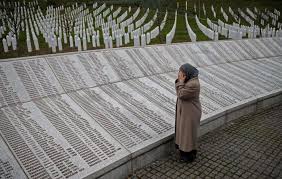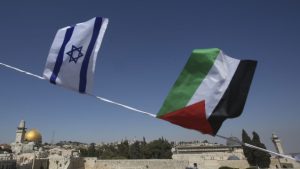
Thirty years after the Srebrenica genocide. The victims’ legal odyssey
Thirty years after the Srebrenica genocide. The victims’ legal odyssey Written for the componente: Armed conflicts Thirty years after
Written for the component:
Armed Conflicts: Gaza

“The dialogue of the occupying power and the occupied territory … is that of two people at war, enemies, equal sovereigns; that of Ulysses and Hector, but in a devastated Troy”.
Alain Pellet, ‘The Destruction of Troy will not Take Place’, writing about Israel’s occupation of Palestine in 1992[1]
In a historic judgment, the International Court of Justice held in July 2024 that Israel’s occupation of Palestinian territory was unlawful and must be brought to an end. Israel must return the land to the Palestinians, pay reparations, evacuate its settlers, dismantle the settlements, and allow all Palestinians displaced during the occupation to return to their homes (Advisory Opinion, para. 270). This is a landmark ruling, going further than even the most inherently optimistic among us had hoped, with the Court saying that it is now for every state in the international community to ensure that the occupation is brought to an end.
Israel’s reaction was boilerplate; Ben Gvir, the national security minister, said the ICJ was a ‘blatantly anti-Semitic organisation’ and Benjamin Netanyahu remarked that “the Jewish people are not occupiers in their own land” continuing the trend of settlers claiming nativity which has anchored this occupation. Meanwhile, the Court, in an albeit non-binding but legally authoritative ruling, has ordered the eviction of 700,000 settlers from the West Bank in favour of those they were expelled to accommodate. While judges are not supposed to respond to the weather of the day, but the climate of the era, it is impossible that the most barbaric face of Israel’s occupation in a yearlong bombardment of the Gaza Strip would not have affected them in coming to this judgment. As it should. Israel’s attempt to trojan horse its brutality as self-defence has not succeeded. The destruction of Troy cannot be allowed.
The ICJ’s Ruling
This article will focus on key elements of the ICJ’s ruling which have caused legal debate, but as Milanovic points out, the most striking part of the opinion is the amount of consensus among the judges on Israel’s violations which render the occupation unlawful (ignoring of course Vice President Sebutinde’s alarming dissent). This consensus was also clear among states in their oral proceedings before the Court. Judge Tladi’s declaration points out that “few States appeared willing to argue that the rules and principles referred to in the question put by the General Assembly have not been violated by Israel” instead focusing on jurisdictional reasons why the Court should not issue the opinion (Judge Tladi Declaration, para. 4). The conclusion for the Court was pretty clear; in that it would declare Israel’s occupation unlawful and that it must be brought to an end. However, it did not get there without some controversy.
Is Gaza Occupied?
One of the key questions before the Court was to determine whether the Gaza Strip was still occupied territory after Israel’s disengagement in 2005. While there were no Israeli boots on the ground, Israel still controlled much as it was able to place a blockade on the territory after Hamas’ election, even going so far as to calculate Gaza’s caloric needs in 2007, putting its inhabitants on a ‘diet’. The Court held that an occupation required effective control which did not always entail a physical military presence on the ground. So long as the state has capacity to enforce its authority, it can be in occupation of that territory (Advisory Opinion, para. 91). The Court went on to hold that Israel remained capable of exercising, and continued to exercise, certain key elements of authority over the Gaza Strip “including control of the land, sea and air borders, restrictions on movement of people and goods, collection of import and export taxes, and military control over the buffer zone, despite the withdrawal of its military presence in 2005. This is even more so since 7 October 2023” (Advisory Opinion, para. 93).
However, the key aspect of its holding was its determination that:
“the Court is of the view that Israel’s withdrawal from the Gaza Strip has not entirely released it of its obligations under the law of occupation. Israel’s obligations have remained commensurate with the degree of its effective control over the Gaza Strip” (para. 94).
The first question is whether Gaza is occupied or not? If it is, which obligations continue to bind it and which do not?
In relation to the first question, Judge Iwasawa argued that the Court did not take a position as to whether Gaza remained ‘occupied’ within the meaning of the law of occupation after 2005 (Judge Iwasawa Separate Opinion, para. 8). The notion then being that Israel cannot have been in occupation of Gaza but still owe it obligations under the law of occupation. Can Gaza be a bit occupied? Milanovic argues that the Court has seemingly adopted the Pictet functional approach wherein occupation is not a binary but on a sliding scale, in that some obligations do apply under the law of occupation but not all. This is similar to his approach regarding the invasion phase of a conflict, where some of the obligations under the Fourth Geneva Conventions related to the law of occupation can be triggered even before the definition in Article 42 of the Hague Regulations (HR) 1907 is deemed fulfilled. Not everybody subscribes to this approach but it is an interesting one. In my view, this question evokes the well-know phrase about interventionist cited in Rupert Smith’s book, The Utility of Force; “Just like you can’t be a little bit pregnant you can’t be a little bit interventionist either”. Is it the same with occupation?
The second question then becomes, if you do believe a territory can be a little bit occupied, which obligations continue to bind Israel in such an event? The Court does not identify which obligations continue to bind Israel and which ones have been violated. Judge Cleveland highlights this as an issue and states that the Court here indicates that Israel did not exercise effective control over day-to-day administration of the Gaza Strip which was under the control of Hamas but its continued control over land crossings, sea and air space means it was still required the abide by certain obligations under the law of occupation. These would include the requirement under Article 55 of the Fourth Geneva Convention to ensure food and medical supplies as well as the duty to facilitate humanitarian relief under Article 59 of GCIV (Judge Cleveland Separate Opinion, paras. 10 and 24).
The key tension, I believe, comes to the fore when it comes to Article 43 of the HR 1907 which states that the occupying power is to restore and ensure public order and safety in occupied territory. If this obligation is not under Israel’s remit, then only Hamas, given its control over day-to-day affairs in the Gaza Strip, has the duty to ensure public order and safety. This may be in tension with the notion of self-defence. Given the ICJ’s previous Advisory Opinion in the Wall case, in which it —albeit in a highly ambiguous paragraph—that there is no right to self-defence in occupied territory (Wall Advisory Opinion, para. 139), it can be argued that the legal framework governing Israel’s actions in the Gaza Strip when under attack is Article 43 HRs. It can use no more force than allowed under this provision (into which are read human rights laws relating to the use of force). If this is not applicable to Israel due to its limited effective control over the territory, then the broader question is under what law can it conduct its operations in the territory if not to ‘restore public order’?
Pre-Emptive Self-Defence
The Court leaves the circumstances of Israel’s occupation vague, saying merely that in 1967, an armed conflict “broke out between Israel and neighbouring countries Egypt, Syria and Jordan” after which Israeli forces occupied all the territories of Palestine under British Mandate beyond the Green Line (Advisory Opinion, para. 57). The court does later also allude to the fact that while an occupation is a state of fact under the laws of war, the exercise of effective control must always comply with the rules concerning the prohibition of the threat or use of force and prohibition of territorial acquisition. So the fact that an occupation is prolonged may have a bearing on the justification under international law of the occupying power’s continued presence in the occupied territory (Advisory Opinion, para. 109).
Judge Charlesworth agrees with this evasion of the question of whether the occupation is lawful under the jus ad bellum. While acknowledging that an occupation is an ongoing use of force, which must comply with the law relating to the use of force (Judge Charlesworth’s Declaration, para. 15), she goes on to say that it is unnecessary to determine whether Israel’s use of force in 1967 had a legal basis. What actually matters, according to her, is whether the legal basis for the occupation is valid today (ibid., para. 17). The extent of Israel’s occupation (57 long years) means that the occupation cannot be necessary or proportionate as a form of self-defence (ibid., para. 27).
The Court did not want to get into thorny issues relating to whether pre-emptive self-defence is lawful under Article 51 or not. Even Judge Sebutinde acknowledged that the 1967 war was a pre-emptive one fought by Israel to remove what she calls an immediate and existential military threat (Vice President Sebutinde Dissenting Opinion, para. 56) later calling it a “clear and present threat, initiated by a group of Arab states, intent on annihilating the Jewish state” (ibid. para. 87).
It is entirely understandable given the extent of state disagreement on this issue that the Court would want to side-step this, but it is a bit frustrating as a reader from the Global South (who wishes to see pre-emptive self-defence as unlawful under the UN Charter) to see even the judge’s separate opinions largely ignore the issue entirely or merely acknowledge the lack of clarity. For instance, Judges Tomka, Abraham and Aurescu note that the Court did not receive sufficient information to rule objectively the respective responsibilities of the various parties involved in the 1967 war and therefore cannot assess the legality of Israel’s use of force (Joint Opinion of Judges Tomka, Abraham and Aurescu, para. 33). It is only Judge Salam who points out correctly that the occupation was itself condemned as unlawful by the General Assembly numerous times in the 1970s (President Salam’s Declaration, para. 35). The international community did not at this point have a prolonged occupation to base their determination of illegality on and yet came to that conclusion presumably based on the UN Charter.
Indeed, it is now clear that Israel attacked Egypt on June 5, 1967 without warning and whilst knowing that the Egyptians did not intend to attack Israel. This is clear from exchanges between Major General Meir Amit, the head of the Mossad, and US Secretary of Defense McNamara on June 1, 1967 when Israel was planning the attack and wanted US support. At the time, US intelligence agencies had concluded that Nasser did not intend to attack Israel, a view that Mossad had shared. These accounts are available to us now and show that even if we accept that a form of pre-emptive self-defence exists under Article 51 of the UN Charter, it may be worth exploring whether Israel’s conduct in 1967 fits the constrained parameters in which such a defence can operate. The historical record seems to suggest that it does not.
Apartheid
In an ambiguous paragraph that will likely challenge international lawyers for the next few years, the Court also implied that Israel’s policies of racial segregation may amount to apartheid. It seemed to shy away from an outright pronouncement of this, despite the fact that a spate of human rights organisations has declared Israel to be an apartheid state. So did Michael Ben-Yair, former Attorney General of Israel, who said in 2022 that Israel had become “an apartheid regime . . . a one state reality, with two different peoples living with unequal rights” (referred to in President Salam’s Declaration, para. 31). Ami Ayalon, former director of the Israeli intelligence service also wrote in his memoirs that: “We’ve already created an apartheid situation in Judea and Samaria, where we control the Palestinians by force, denying them self-determination” (ibid.).
While the Court was clear that a system of racial segregation exists in Palestine imposed by Israel, it did not definitively proclaim it an apartheid. The Court held that a violation of Article 3 of Convention on the Elimination of All Forms of Racial Discrimination had occurred, as Israel’s policies and practices in the West Bank and East Jerusalem enforce a near-complete separation between Palestinians and Israeli settlers (Advisory Opinion, para. 228). The ICJ ruled that while this separation is physical, in the form of fragmenting the Palestinians into enclaves as well as discriminatory practices such as residence permit systems and the use of distinct road networks (para. 226), it is also legal as a result of the expansion of Israeli law into these territories and the application of distinct legal systems (para. 228).
Article 3 of CERD stipulates that “States Parties particularly condemn racial segregation and apartheid and undertake to prevent, prohibit and eradicate all practices of this nature in territories under their jurisdiction”. Racial segregation appears to be the broader term with apartheid being the more grave form of segregation (Judge Nolte’s Separate Opinion, para 16). However, it does not define apartheid which is a crime against humanity under the Rome Statute and a violation of human rights law (as per the Apartheid Convention).
Several judges commented on this finding in their separate opinions. Judge Salam noted that while the Apartheid Convention is marked by the experience of South Africa, it cannot be that the definition of apartheid is entirely constrained by the policies and measures implemented by that state at that time (President Salam’s Declaration, para. 16). No state currently would openly claim to pursue a policy of racial segregation as was practiced by South Africa (ibid). Judge Tladi echoes this when he comments that there is an understandable reluctance to describe Israel’s conduct as apartheid given the South African situation, though he also notes that South Africa openly described its policies as apartheid in a positive light to explain its benevolent pursuit of ‘separate development’. He goes on to say that “Once the term attained a negative meaning…no other State would self-describe its policies as apartheid (Judge Tladi’s Declaration, para. 36). He concludes that it is impossible not to come to the conclusion that the practices of South Africa and Israel are similar given the “separate roads, separate schools, separate facilities, and separate legal systems” as well as the detention practices, “residence permit system, restrictions of movement or demolition of property, deprivation of land, or the encircling of Palestinian communities into enclaves reminiscent of South African Bantustans from which I come, it is impossible to miss the similarities” (Judge Tladi’s Declaration para. 37).
The role of South African lawyers and judges in identifying and denouncing apartheid is well documented. Former UN Special Rapporteur in Palestine and jurist John Dugard, in comparing apartheid Israel to South Africa, noted that: “Both systems of apartheid have imposed heavy restrictions on freedom of movement, but South Africa never excluded blacks from public roads. South Africa reserved parks and beaches for exclusive white use but never built a wall to separate blacks and whites. South Africa built separate schools and hospitals for blacks, but Israel has not built any such amenities for Palestinians…No black community in South Africa was subjected to a blockade and carefully calculated restrictions on foodstuffs.”
Judge Xue in her separate opinion also referred to Archbishop Desmond Tutu’s remark that: “I have been very deeply distressed in all my visits to the Holy Land, how so much of what was taking place there reminded me so much of what used to happen to us Blacks in Apartheid South Africa. I have seen the humiliation of the Palestinians at the roadblocks and recall what used to happen to us in our motherland” (Judge Xue’s Declaration, para. 4)
While Judge Iwasawa too states that differential treatment between Palestinians and settlers is also found in the national health insurance law, taxation law, election law, and even in the enforcement of traffic laws (Judge Iwasawa Separate Opinion, para 10), he believes that the Court did not hold that this separation qualified as apartheid (ibid. para. 13). This is supported by Judge Nolte who goes further to say that he does not believe that the Court has enough information before it to conclude that there is either racial segregation or apartheid (Judge Nolte’s Separate Opinion, para. 8). Judge Nolte states that he doubts whether the only reasonable inference to be drawn from Israel’s policies and practices is that of an institutionalised régime designed to systematically oppress and dominate the Palestinians in relation to Israeli Jews. While what is happening may be a violation of human rights, they are being pursued due to “temporary, albeit long-term, security considerations (even if they are unjustified)” or “driven by the misconceived and illegal aim of asserting sovereignty over the West Bank” (ibid. para. 13). And therefore, the intention for segregation along racial lines is not present (ibid. para. 16). He justifies this further on the basis that the law of occupation itself envisages a difference in treatment between the nationals of the occupying power and the protected population in occupied territory (ibid. para. 18). The overlap here between CERD and the law of occupation offers for him a conclusion in the opposite direction, that human rights is violated sure, but apartheid it is not (ibid. para. 18).
Judge Tladi rebuts the argument there is insufficient proof that inhumane acts were committed with the intent for racial domination saying that he finds this impossible to accept even if we accept that domination might not even be the sole or even dominant reason for the discriminatory measures (Judge Tladi’s Declaration, para. 39-40). Israel may be pursuing a number of different aims at the same time in its discriminatory measures, but that does not mean that the intention to dominate another race is not present, or that it is not apartheid. In my view Judge Nolte’s argument does not pass the sniff test. The larger question of whether there can be a system of racial segregation which falls just short of apartheid might be a moot one. A racially segregated society does not have to be South African in every way to qualify as an apartheid state.
Resistance to Occupation
The Court also rubbished the fact that the occupation was required to meet Israel’s security needs and obligations, stating that a permanent presence and annexation of territory cannot be required to meet its security needs (Advisory Opinion, para. 263). It is also worth noting that while China was the only state in the oral proceedings to say that the Palestinians have the right to achieve self-determination through armed struggle, Judge Charlesworth noted too that “the population in the occupied territory does not owe allegiance to the occupying Power, and that it is not precluded from using force in accordance with international law to resist the occupation” and that this resistance does not in itself justify the maintenance by Israel of its occupation (Judge Charlesworth’s Declaration, para 23). Judge Tladi also adroitly refers to the fact that all states have security concerns, not just Israel, and that Israel’s security concerns cannot override those of Palestine’s (Judge Tladi’s Declaration, para. 44).
There was a sad dearth of states appearing before the Court to argue that the Palestinians had the right to resist the occupation. This may be an attempt to distance themselves from the horrific acts carried out on October 7, 2023 but it is important that states remember that these war crimes should not rule out the right to resist altogether. This much understudied and underdiscussed right needs the stamp of approval by more states, not fewer, especially in light of the current barbaric onslaught from Israel.
The Consequences of the Ruling
The Court has ordered all other states to not aid or assist Israel in maintaining its occupation. Any state now doing so, through weapons or aid or trade, would also be breaching their international obligations. All states must also work together through the General Assembly and the Security Council to ensure that Israel brings its occupation to an end and dismantle its settlements and regime of annexation. In terms of the landmark nature of this ruling, it echoes that of the ICJ’s Advisory Opinion of 1971 which said South Africa’s occupation of Namibia at the time was illegal, and which then helped end that occupation. While the end of the apartheid regime came more than two decades later, the judgment was an important step in the journey to justice for Black people in Namibia and South Africa.
In this case, the Court has issued a powerful opinion in favour of the Palestinian people under occupation, concluding that:
The sustained abuse by Israel of its position as an occupying Power, through annexation and an assertion of permanent control over the Occupied Palestinian Territory and continued frustration of the right of the Palestinian people to self-determination, violates fundamental principles of international law and renders Israel’s presence in the Occupied Palestinian Territory unlawful. (Advisory Opinion, para. 261)
However, the onus is now on the international community to ensure its implementation. Judge Tladi pleads that “the 285 paragraphs of this Advisory Opinion will be meaningless if the United Nations does not act upon the advice provided by the Court to promote the resolution of this conflict which is a large stain on the claim that there exists an international community, for how can any community permit such indignity and suffering as that imposed on the Palestinian people” (Judge Tladi’s Declaration, para. 63). International law should not perish beneath the rubble of Gaza; the international community must honour the Court’s ruling and not allow the destruction of Troy to take place.
[1] Alain Pellet, ‘The Destruction of Troy Will not Take Place’ in Emma Playfair (ed), International Law and the Administration of Occupied Territories: Two Decades of Israeli Occupation of the West Bank and Gaza Strip (Clarendon Press 1992) 169, 173.
The opinions expressed here do not represent the stance of the CIV or the entities to which the authors are or were affiliated.
Ayesha Malik is the Deputy Director of RSIL’s Lahore Office, Team Lead at the Conflict Law Centre and a Senior Research Fellow. The CLC publishes reports and policy papers relating to war law in Pakistan and Ayesha is Editor of the CLC Blog, host of the CLC’s Podcast series @War and the webinar series with international authors regarding their books on IR, foreign policy, and war law. She is also Editor-in-Chief for the Diplomacy, Law and Policy Forum, a project with the International Committee for the Red Cross which publishes blogs, podcasts and videos on thematic areas of the law of armed conflict.

Thirty years after the Srebrenica genocide. The victims’ legal odyssey Written for the componente: Armed conflicts Thirty years after

The necessity of public and governmental support for transnational justice: the case of the Kosovo Specialist Chambers Written for the

Syria’s Transitional Government and International Law Written for the component: Peace Building and transitions Syria’s Transitional Government and International

An Unlawful Occupation of a Devastated Territory Written for the component:Armed Conflicts: Gaza “The dialogue of the occupying power

From Chaos to Clarity: How Conflict Classification Enhances Peacebuilding Written for the component: Peace Building and Transitions Introduction In today’s

Last Three Years Without serious consequence: Overview of the nature and Challenges of Russia’s War Against Ukraine under The International


To receive more information about our newsletter, please leave us your email address.